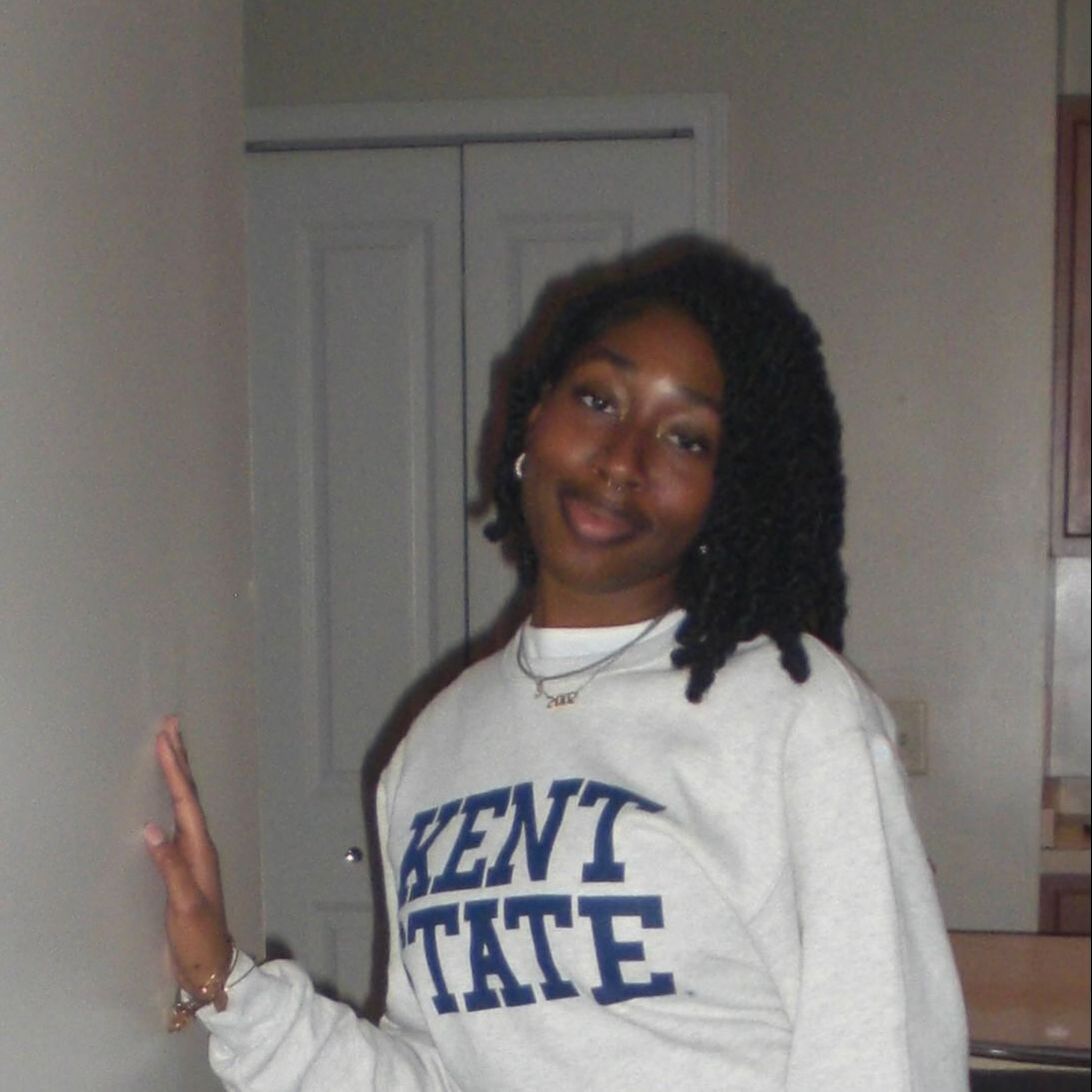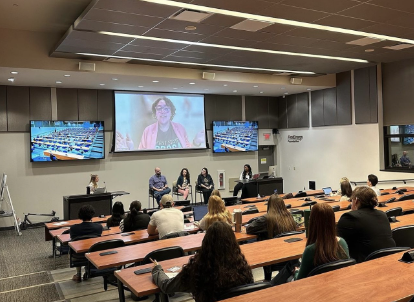|
Angie Robinette
PRSSA Kent launched its spring semester programming with an insightful meeting all about the event planning industry. Students learned about different sides of the field from Kelly Needham, Director of Development Programs at the Cleveland Clinic, Heather Shaw, Special Events Manager at the Akron Zoo and Nora Culley, Wedding Planner at Engaged with Nora. Each speaker explained how they got into event planning, revealed their favorite and not-so-favorite parts and offered valuable advice to anyone interested in the career field. Here are some key takeaways to make sure you can excel in the world of event planning: 1. Don’t be afraid to make mistakes No event will go smoothly, especially when first starting out in the field, so it is okay to make mistakes. However, it is important to fix them and come up with solutions on your own. “Embrace the fact that you are going to make mistakes. They’re going to be big and small but really just own up to it and bring the solution to how to fix it,” Needham said. “I think having that forward-thinking, solutions-oriented mindset is what will be really critical.” 2. Have backup plans When something goes wrong, it is helpful to be prepared for the specific situation. Similar to crisis management, event planners must plan for the worst. “Just make sure that in your mind you have those plans of what’s going to happen and how you’re going to handle yourself,” Shaw said. “I think a lot of them are skills that you can learn, but be ready to zig when people zag, and go from there. 3. Get as much hands-on experience as possible In event planning, it is important to experience every side of the operation so you can understand the different perspectives and how they each function. “Get as much on the ground experience as you possibly can. You have to understand that live events are an organism, everything in it is moving and everybody has their own job,” Culley said. “You have to know how everybody else is doing their job or else you’ll never know how to do your own.” 4. Set boundaries Every speaker also mentioned the importance of setting boundaries between yourself, your job and clients because burnout is very common in event planning. MaKayla Edmond, a junior hospitality and event management major, said “I enjoyed the parts about what they said about burnout and how you have to set those boundaries with people. Especially because I'm a people pleaser. I want to be able to give my best to everyone at all times and sometimes that’s not feasible.” Event planning is an intriguing industry, but there are a lot of moving parts and perspectives to be learned. The Precision in Planning: Elevating Events meeting was an amazing lens into the event planning world and a great way to start off the spring semester.
0 Comments
Senior public relations student Samira Brown’s journey to public relations began by taking Principles of Public Relations, a rite of passage for students first joining the major.
Brown originally came to Kent State as a journalism major but decided to switch after narrowing her career path. “In journalism, I didn’t know what I wanted to do with the major, but taking Principles of Public Relations helped a lot with deciding my career path,” Brown said. The variety of careers in the field of public relations was a major factor for Brown in making the switch. “I want to go into sports or entertainment PR,” Brown said. “As I took more classes, I realized public relations fit more of what I wanted to do in my career path.” While at Kent State, Brown noted that her identity as a black woman has influenced her public relations and college journey. “I went to a predominantly black high school, so coming into a predominately white institution was different for me as I am still trying to figure out myself as I'm getting older,” Brown said. Coming to a predominantly white institution (PWI) has helped Brown interact with classmates and people she did not know before. “It can be challenging not seeing a lot of people looking like me,” Brown said. “It’s important to surround yourself with people who think and look differently to get different perspectives.” Diversity, Equity, Inclusion & Belonging in the field of public relations remains an important topic of conversation. Brown encouraged public relations professionals to include DE&IB in their everyday lives. “Being inclusive and making sure that you know the people around you are diverse allows you to think about other perspectives,” Brown said. When incorporating DE&IB initiatives, Brown cautioned that it is important organizations and people steer clear of being performative. “Sometimes people will do it when it looks good,” Brown said. “It should be one of your morals that you always check yourself on.” Despite Kent State being a PWI, Brown says that her professors have done a good job of talking and covering DE&IB topics. “When it comes to DE&IB, you’re either conscious about it or you’re not,” Brown said. “The professors I have had in PR are conscious of the things they say and talk about.” Brown ultimately believes that Kent State, the School of Media and Journalism and the PR sequence do a good job of acknowledging DE&IB initiatives. “My professors always make everybody feel included and cover topics of diversity when it’s needed,” Brown said. “Everyone here is very welcoming.” Alex Zito
Andrea Gils, marketing and communications director at Hargrove Firm LLC, initiated the meeting with an introduction to OpenAI’s ChatGPT, highlighting the significance of prompt generation and the need for careful guidance in crafting prompts to generate useful outputs. Linda Staley, corporate communications manager at Carilion Clinic, shared her experience with ChatGPT in the communications group at Carilion Clinic, using it as a brainstorming tool for generating headlines, speech outlines and research topics. She emphasized the importance of human oversight and the model's predictive capabilities, which make it seem like interacting with another person. Michele Ewing, a public relations professor at Kent State University, echoed the sentiment of AI as a brainstorming aid, stressing the importance of transparency and data security. She discussed the challenges of ensuring the accuracy and bias-free content of AI-generated materials, advocating for critical thinking and human creativity in the process. Ben Brugler, president and CEO of Akhia Communications, spoke about the initial oddity of using AI and the importance of adapting to its capabilities. He shared various applications of AI in his work and stressed the necessity of verifying the accuracy of AI-generated content. Brugler also highlighted the distinction between ChatGPT and Claude, favoring the latter for research and client communication. Collective Insights on AI Use in Professional Settings: - Ben Brugler talked about the slow adoption of AI in the industry, calling for greater usage among professionals. - Andrea Gils mentioned using AI to create videos with digital avatars for internal communications and client briefings. - Linda Staley advised on the inevitability of AI becoming a valuable tool for practitioners and stressed the importance of understanding its workings, limitations and potential. Comprehensive Recap of AI Ethics Panel The meeting covered a broad spectrum of topics related to AI ethics and its application in professional settings, focusing on communications and public relations. The panelists discussed their personal experiences with AI tools like ChatGPT and Claude, emphasizing the role of these technologies as aids in brainstorming, content creation and research. Key points included the need for human oversight to ensure accuracy and mitigate biases, the importance of transparency in AI use and the potential ethical implications of deploying AI-generated content. Linda Staley shared insights from the PRSA's Board of Ethics and Professional Standards, highlighting the obligation of communicators to practice ethically and the guidance developed to navigate AI's ethical use. This includes verifying the accuracy of AI-generated content, being cautious with sensitive information and being transparent about AI tool usage. Ben Brugler discussed the necessity of AI-proofing brands, focusing on crisis management, corporate consultation and the ethical responsibility of maintaining a human touch in communications. He emphasized the importance of educating oneself and clients about AI's potential impacts and opportunities. Michele Ewing and Andrea Gils highlighted the importance of understanding and adhering to ethical standards in AI usage, pointing out the dangers of biases and the need for transparency and fairness. The panelists agreed on AI's transformative potential in communications and public relations, urging professionals to embrace these technologies while maintaining ethical standards and human judgment. The discussion concluded on the note of AI's inevitable role in shaping the future of professional practices, underscoring the importance of proactive and informed engagement with these tools to leverage their benefits ethically and effectively. Cassidy Grentz
Internal communication is a critical component for any organization. On November 13, PRSSA Kent had the opportunity to learn how internal communications creates and fosters a positive workplace culture. The speakers gave examples of their organization's internal communications campaigns. Box Internal Communications Specialist Latisha Ellison mentioned the Proud Cloud award. “Each month folks can nominate other boxers who have gone above and beyond while exemplifying our values,” Ellison said. “We recognize our Boxers, and it is nice to hear untold stories that we don’t always get to know, especially if we’re not in the same function.” Jon Gellot, senior communications specialist at Progressive Insurance, spoke on how holiday fun can foster workplace relationships. Progressive’s annual Halloween celebration helps employees see the executives as real people. “For three years, I have run the Progressive Halloween celebrations,” Gellot said. “We utilized the virtual space to get multiple organizations and each member of the executive team's groups represented, then had a live game show setting where I put the executives in last year and this year was a pre-recorded box of lies, Jimmy Fallon Sketch.” The meeting's discussion also covered the importance of internal communications concerning inclusivity and diversity in the workplace. “I think something that works at the Cleveland Clinic is making sure the right folks are in the room when it comes to sculpting a communications plan around certain initiatives,” Lindsay White, Cleveland Clinic program manager and human resource communications in the Cleveland Clinic caregiver office said. “Our office of Diversity Equity and Inclusion has employee resources available for caregivers to enjoy at their leisure. It allows caregivers to get involved outside of their role.” White emphasized the importance of making sure all employees are heard and the organization's initiatives are being broadcasted. Barb Barkely, Goodyear Tire and Rubber Company global internal communications manager, mentioned the organization's global employee resources and the importance of a diverse team. “It is important to have diverse viewpoints on a team, it just makes good business sense and we are doing better when we have a diverse workforce,” Barkley said. As communicators, it is really important that we think through being inclusive. Not everyone is comfortable speaking up in a meeting, not everyone processes information at the same rate. Just because it is comfortable for you doesn’t mean it's comfortable for everyone.” Students were eager to hear about internal communications, especially Senior PR major Emily King. “It was great to hear about the internal side of communications. In courses at Kent, we tend to only learn about how to communicate with external audiences and with the media, but it’s just as important to communicate with the employees who are the most important stakeholders,” King said. “I also learned some great practices and new ways to spotlight employees!” Whether it’s showing employee appreciation, providing information about employee resources or building relationships through holiday fun, internal communications is essential to the success of any organization. Evelyn Willet
When big-time gaming company Activision Blizzard came out with Overwatch 2, it was supposed to be new and improved. The game was promised to have upgrades like more characters, faster loading speeds and updated player-versus-player options, changes both fans and critics of the game anticipated for three years. Overwatch 2 came out on October 2, 2022. It’s been over a year since it made history as the worst-rated game on Steam and a year since Activation Blizzard made one of the gaming industry’s largest PR mistakes: overpromising and underdelivering. It was like receiving half of your food order after paying the full price. Overwatch 2 took away parts of the game that players liked, like 6v6, and replaced them with minor upgrades. Upgrades players anticipated within the game never came to fruition either. Game visuals were practically the same and there weren’t a lot of new characters. What put Blizzard in deep water was one of the main reasons for making Overwatch 2 in the first place: there was no PvE or player versus environment content an addition Blizzard promised. Blizzard was seemingly marketed on a broken promise. What was said to be Overwatch 2 was just Overwatch 1/2 with minor changes and no PvE. The company's game director, Aaron Keller, told Verge that it could not deliver the PvE mode because Blizzard was “trying to do too many things at once,” and the team “lost focus.” Other comments coming from Blizzard were released, but the gaming community was furious about having their trust broken. “They (Activation Blizzard) can’t even listen to the community or the pros when it comes to making the gamer great,” a reviewer on Google Reviews wrote. “For any developers out there, please compete with this game and make a better one. It isn't hard to compete with the developers that don't talk to anyone, be it pros or players/ community.” Let's dissect the PR pitfalls that Blizzard made before and during the release of Overwatch 2 now that we understand what happened.
Blizzards Overwatch 2 is an example to PR practitioners of the consequences that come with a broken promise. Years of prestige and good games can come to a halt when companies decide to ignore the very voices and opinions that pay their bills. If there is one lesson Blizzard has taught, it’s that for your company to succeed, you need to prioritize its customers’ needs. Don’t play your public, or it's game over for your company. |
Archives
February 2024
Categories
All
|





 RSS Feed
RSS Feed
